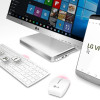LG G5 Adopts Metal Design, Adds Trick Battery Hatch
Feb 21, 2016, 8:00 AM by Eric M. Zeman

LG today announced its flagship handset for 2016, the G5. The phone represents a re-think from LG, which has altered the design and functionality entirely from earlier G models to help set it apart from competing phones. The G5's stand-out feature is a removable hatch that opens the battery compartment and also allows modular accessories to be added to the phone, such as a camera grip. Other significant changes include a shift from plastic materials to metal, and relocating the volume buttons from the back of the phone to the side. The power button, which doubles as a fingerprint sensor, remains on the rear panel. The G5 has a 5.3-inch quad HD display and is powered by a Snapdragon 820 processor with 4 GB of RAM. The main screen includes an always-on feature similar to the V10, but without a separate screen. It comes with 32 GB of storage, but supports memory cards up to 200 GB. LG bestowed the G5 with dual rear cameras. The main shooter rates 16 megapixels at f/1.8 and a normal 75-degree field of view. The second camera rates 8 megapixels and has a wider, 135-degree field of view. Both cameras are assisted by laser focus and can capture 4K video. The user-facing camera has an 8-megapixel sensor and captures full HD video. Other hardware features include a 2,800 mAh battery with Quick Charge 3.0, USB Type-C, Bluetooth 4.2, GPS, NFC, WiFi, and of course LTE. The phone runs Android 6.0 Marshmallow and LG toned its user interface skin way back. The LG G5 comes in four colors (silver, titanium, gold, pink) and will be sold by major U.S. carriers come April. Pricing was not revealed.
source: LG
Comments
Removable Battery
Regardless of price or premium status, the battery is the weakest link across the board. I have contended all along that a premium device should not be rendered useless just because of a battery issue. Thanks to the industry, it has slowly groomed the consumers to "Accept" the inevitable. What this has done, is add an additional 36 billion dollars in service for handsets within the industry. Are we really this dependant on service cen...
(continues)


 Review: LG G5 for AT&T
Review: LG G5 for AT&T
 Hands On with the LG G5
Hands On with the LG G5
 LG Announces the V20 With Android 7, Second Screen, and Dual Cameras
LG Announces the V20 With Android 7, Second Screen, and Dual Cameras
 LG's VPInput App Lets PCs Control Smartphones Via Bluetooth
LG's VPInput App Lets PCs Control Smartphones Via Bluetooth
 LG Begins Selling G5 Friends Directly Online
LG Begins Selling G5 Friends Directly Online
 LG G5
LG G5



